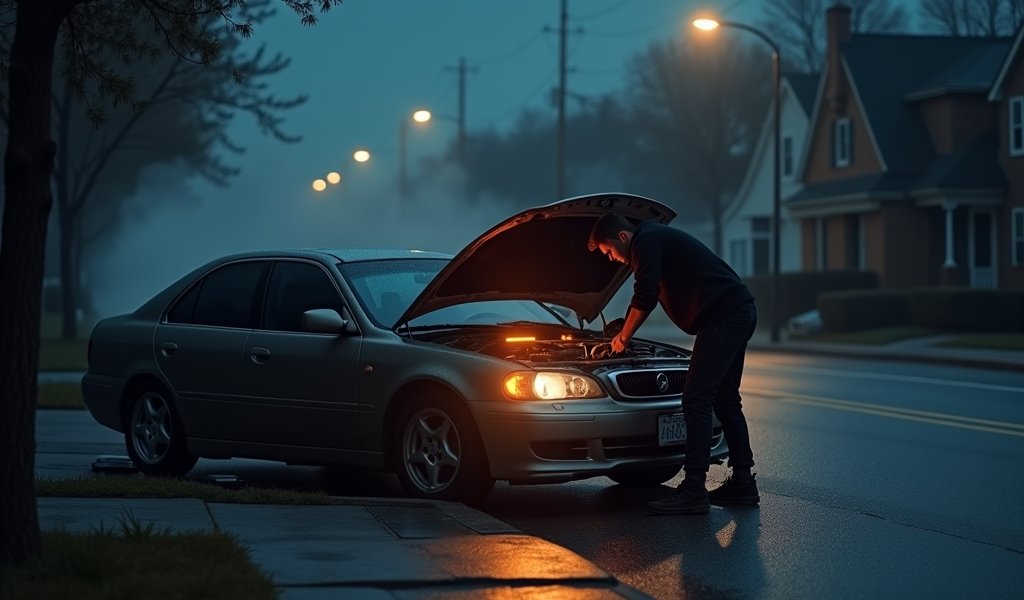Overview
This article outlines five common causes of check engine light warnings that drivers can often fix themselves: loose gas caps, faulty oxygen sensors, worn spark plugs, clogged air filters, and battery problems. Each issue is explained with specific symptoms, step-by-step DIY repair instructions, and cost comparisons between self-repair and professional service.
Table of Contents
- Why Your Check Engine Light Illuminates
- Loose or Damaged Gas Cap: The Simplest Fix
- Faulty Oxygen Sensor: DIY Replacement
- Spark Plug Issues: Restore Your Engine’s Spark
- Dirty or Clogged Air Filter: Let Your Engine Breathe
- Battery and Charging System Problems
- When to Seek Professional Help
- Conclusion: Addressing Check Engine Light Issues
- Frequently Asked Questions
Why Your Check Engine Light Illuminates
That moment when your check engine light suddenly illuminates can send a wave of anxiety through any driver. I’ve seen countless worried faces roll into my shop, imagining the worst (and most expensive) scenarios. After 25 years under the hood, I can tell you with confidence – many check engine light causes have surprisingly simple fixes that won’t drain your wallet.
Your vehicle’s check engine light (technically called the Malfunction Indicator Lamp) is part of your car’s onboard diagnostic system. When it detects something outside normal operating parameters, it triggers this warning. The beauty is that most modern vehicles will store a specific trouble code that points to what triggered the light.
While some issues do require professional attention, I’ve identified five common check engine light causes that many drivers can address themselves with basic tools and minimal mechanical knowledge. These fixes could save you a costly trip to the shop and give you the satisfaction of solving the problem yourself.
Loose or Damaged Gas Cap: The Simplest Fix
It might sound too simple to be true, but a loose gas cap is one of the most common check engine light triggers I see in my shop. Your gas cap isn’t just there to keep fuel from splashing out – it’s actually an important component of your vehicle’s evaporative emissions control system (EVAP).
When your gas cap is loose, cracked, or missing altogether, your car’s computer detects a vapor leak in the fuel system. This triggers the check engine light because your vehicle is programmed to alert you to any potential emissions problems, as required by EPA vehicle emissions standards.
The fix couldn’t be easier:
- Pull over safely and check your gas cap
- If it’s loose, tighten until you hear several clicks (typically 3-4 clicks indicates proper tightening)
- If damaged, replace with a new cap that matches your vehicle specifications (available at any auto parts store for $5-$20)
- Drive for 50-100 miles to allow your car’s computer to run its diagnostic cycle
In most newer vehicles, the check engine light will turn off automatically after several driving cycles with the problem resolved. Older vehicles might need the code cleared with a scan tool, which most auto parts stores will do for free.
This five-minute fix costs essentially nothing if just tightening, or under $20 for a replacement cap. I’ve seen drivers save hundreds by checking this simple component before heading to a shop.

Faulty Oxygen Sensor: DIY Replacement
Oxygen sensors (O2 sensors) are among the most common reasons for check engine lights in vehicles with over 100,000 miles. These finger-sized devices monitor the oxygen content in your exhaust system, helping your engine’s computer adjust the air-fuel ratio for optimal efficiency.
When an O2 sensor fails, your engine typically runs “rich” (too much fuel, not enough air). This wastes fuel and can cause your engine to overheat or damage your catalytic converter over time – a much more expensive repair.
Signs of a faulty oxygen sensor include:
- Poor fuel economy (up to 40% worse in some cases)
- Rough idling or hesitation during acceleration
- Black exhaust smoke or sulfuric “rotten egg” smell
- Failed emissions test
Replacing an oxygen sensor is more involved than checking a gas cap, but still manageable for most DIYers:
- Use an OBD-II scanner to identify which sensor needs replacement (most vehicles have 2-4)
- Purchase the correct sensor for your make and model
- Allow your vehicle to cool completely (exhaust components get extremely hot)
- Locate the faulty sensor (usually in the exhaust manifold or downstream pipes)
- Disconnect the sensor’s electrical connector
- Remove the old sensor with an oxygen sensor socket
- Apply a small amount of anti-seize compound to the threads of the new sensor (unless pre-treated)
- Install the new sensor and reconnect the wiring
DIY cost runs about $40-$150 for the sensor itself (depending on your vehicle) plus about $25 for the special socket if you don’t already own one. Compare that to a professional repair cost of $200-$500, and the savings become quite attractive.
This job typically takes 30-60 minutes for someone with basic mechanical skills and the right tools. Just be sure to work on a completely cool engine to avoid burns from hot exhaust components.
Spark Plug Issues: Restore Your Engine’s Spark
I’ve lost count of how many check engine lights I’ve fixed with a simple spark plug replacement. These humble components are responsible for igniting the air-fuel mixture in your combustion chambers. When they deteriorate, misfires occur that can trigger your check engine light.
Spark plugs don’t fail overnight – they gradually wear down over thousands of miles. Modern plugs with platinum or iridium tips can last up to 100,000 miles, but standard copper plugs typically need replacement every 30,000-50,000 miles. Your owner’s manual will specify the right interval for your vehicle.
Signs your spark plugs might need replacing include:
- Engine misfires (feeling a slight hesitation or stumble)
- Rough idle or difficulty starting
- Reduced acceleration and increased fuel consumption
- Check engine light with misfire codes (P0300-P0312)
Replacing spark plugs is one of the most satisfying DIY maintenance tasks because the improvement in performance is often immediately noticeable. For a comprehensive step-by-step guide, I recommend checking out this detailed spark plug replacement guide that covers the process thoroughly.
For most 4-cylinder engines, you’ll need:
- New spark plugs specified for your vehicle (around $4-$25 each)
- Spark plug socket and ratchet
- Gap tool (if your plugs aren’t pre-gapped)
- Torque wrench (highly recommended)
- Dielectric grease for the boot connections
Total DIY cost typically ranges from $16-$100 for a complete set of plugs. Compare that to professional replacement costs of $150-$400, and you’re looking at significant savings.
The job takes about 1-2 hours for most DIYers with basic mechanical skills. Just be careful not to overtighten the new plugs – this is where a torque wrench proves invaluable, as over-torquing can damage expensive cylinder heads.
Dirty or Clogged Air Filter: Let Your Engine Breathe
Your engine needs a precise mixture of fuel and air to operate efficiently. When your air filter becomes clogged with dirt, pollen, or debris, your engine can’t “breathe” properly. This imbalanced air-fuel ratio can trigger your check engine light.
Think of your air filter as your engine’s lungs. Just like you’d have trouble running with a dust mask on, your engine struggles when its air supply is restricted. According to research from the U.S. Department of Energy, a clean air filter can improve acceleration time by up to 11% in older vehicles.
Checking your air filter is one of the easiest maintenance tasks:
- Locate the air filter box (typically a black plastic box with clips or screws)
- Open it by releasing the clips or removing fasteners
- Remove the filter and hold it up to a light source
- If light barely passes through, it needs replacement
Replacing the filter is equally simple – just install the new one in the exact same orientation as the old one and secure the housing. Most vehicles need a new air filter every 15,000-30,000 miles, but dusty environments may require more frequent replacement.
This 10-minute job costs just $10-$25 for the filter itself, compared to $50-$100 at a service center. It’s the definition of a quick, affordable fix that can prevent check engine light issues.

Battery and Charging System Problems
Many drivers are surprised to learn that battery issues can trigger check engine lights. Modern vehicles rely on steady, consistent voltage to operate their sophisticated sensors and computers. When voltage fluctuates or drops too low, sensor readings become inaccurate, causing the engine computer to detect problems that may not actually exist.
I’ve seen many frustrated customers who replaced various components based on error codes, only to discover the real culprit was a failing battery or charging system. These systems are interconnected – your battery provides initial power, then your alternator takes over to run the vehicle and recharge the battery.
Signs of battery or charging system problems include:
- Slow or difficult starting
- Dimming headlights or interior lights
- Multiple warning lights on the dashboard
- Electrical accessories behaving erratically
Checking for battery issues is relatively simple:
- Inspect battery terminals for corrosion (white or blue powdery substance)
- Clean terminals with a wire brush and baking soda solution if necessary
- Ensure connections are tight and secure
- Test battery voltage with a multimeter (should read 12.4-12.7V with engine off, 13.5-14.5V with engine running)
Battery maintenance costs nothing beyond basic cleaning supplies, while replacement runs $75-$250 depending on your vehicle. Most auto parts stores will test your battery and charging system for free, helping you determine if replacement is necessary.
While replacing a battery is generally straightforward, be aware that some modern vehicles require a reset procedure after battery replacement. This might involve a scan tool or specific sequence to reset the vehicle’s computer systems, particularly for fuel injection systems that need to relearn idle and fuel delivery parameters.
When to Seek Professional Help
While I’m a big advocate for DIY repairs when appropriate, there are definitely situations when you should seek professional assistance for check engine light issues. Your vehicle is a complex machine, and some problems require specialized tools and expertise.
Consider professional help when:
- Your check engine light is flashing (this indicates a severe problem that could cause catalytic converter damage)
- The light returns shortly after you’ve attempted a fix
- You’re experiencing serious performance issues like power loss, overheating, or unusual noises
- The error code points to internal engine or transmission problems
- You lack the tools or confidence to perform the repair safely
When choosing a repair shop, look for:
- ASE-certified technicians (Automotive Service Excellence certification)
- Good reviews specifically mentioning check engine light diagnosis
- Shops that explain the problem clearly and don’t pressure you
- Places that offer a warranty on their work
A good mechanic should always be willing to show you the faulty part and explain what went wrong. They should also provide a detailed estimate before beginning work and contact you if additional issues are discovered.
Conclusion: Addressing Check Engine Light Issues
Throughout my years as a mechanic, I’ve seen countless drivers panic at the sight of a check engine light, only to discover the fix was simpler (and cheaper) than they feared. These five common issues – loose gas caps, faulty oxygen sensors, worn spark plugs, clogged air filters, and battery problems – account for a significant percentage of all check engine light activations.
Taking a methodical approach to diagnosing and fixing these problems can save you hundreds in unnecessary repair costs. Even if you’re not mechanically inclined, simple checks like inspecting your gas cap or air filter require no special skills and might resolve the issue immediately.
Remember that your vehicle’s check engine light is actually a helpful tool, designed to alert you to problems before they become serious. Addressing these warnings promptly often prevents more extensive (and expensive) damage down the road.
Whether you tackle the repair yourself or seek professional help, understanding these common triggers helps you approach the situation with knowledge instead of anxiety. Your vehicle is designed to last for many years with proper maintenance – and knowing how to respond to warning lights is an important part of that care.
Keep these tips in your mental toolbox, and that check engine light might never seem quite so intimidating again. After all, sometimes the solution is just a gas cap click away.
Frequently Asked Questions
Can I drive my car with the check engine light on?
If the light is solid (not flashing), you can typically drive for a short period while planning repairs. A flashing check engine light indicates a severe problem that requires immediate attention to prevent damage.
How much does it cost to diagnose a check engine light?
Many auto parts stores offer free code reading, while professional diagnosis typically costs $75-$150. This diagnostic fee is often applied toward repair costs if you have the work done at the same shop.
Will disconnecting the battery reset the check engine light?
Disconnecting the battery may temporarily turn off the light, but it will return if the underlying problem isn’t fixed. This approach also resets other vehicle systems and is not recommended as a solution.
How soon should I address a check engine light?
For a steady light, aim to diagnose the issue within a week of it appearing. Prompt attention prevents minor issues from developing into major problems and maintains your vehicle’s efficiency.
Why does my check engine light come on in cold weather?
Cold temperatures can cause temporary sensor issues or affect battery performance, triggering the light. The light often resolves once the vehicle warms up, but persistent cold-weather activation should be diagnosed.


Pingback: Catalytic Converter Efficiency: 5 Fixes - knowsyourcar.com